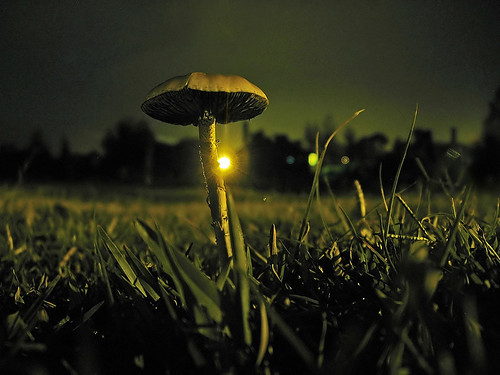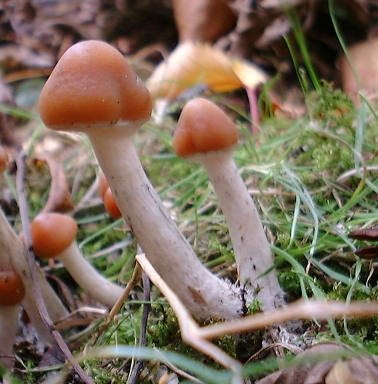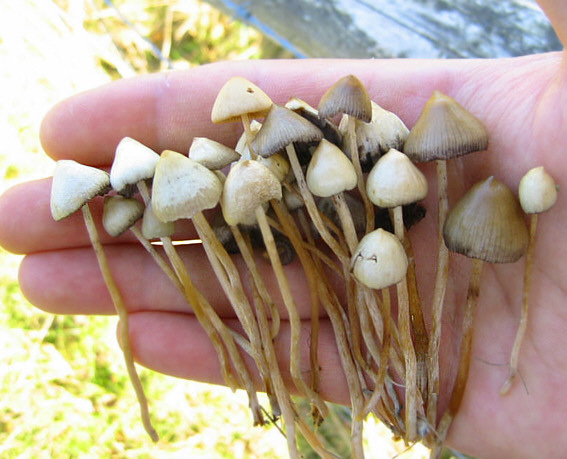Like the title says. 
Pics would be appreciated.
Peace

Pics would be appreciated.
Peace

Psychoactive Mushroom Species
A list of psychoactive mushroom Species
Genus Conocybe
Conocybe is a fairly large genus with over 50 species in North America alone. At least one species in this genus, Conocybe filaris (= Pholiotina filaris), is deadly poisonous. Conocybes are often called dunce caps or cone heads because they usually have a conical or bell-shaped cap. They are mostly fragile, often ephemeral, Mycena-like mushrooms with a long, thin and fragile stem and rusty-brown to ochre-brown spores. Conocybes are largely differentiated on microscopic characters. They are sometimes confused with genus Psilocybe mushrooms, but have brighter brown spores. Among the brown-spored mushrooms, they are easily to be confused with Bolbitius, which usually have a distinctly viscid, striate cap, and Galerina, which have a filamentous rather than cellular cap cuticle (it looks like weaved fibers under the microscope whereas those of Conocybe are composed of inflated round cells resembling cobblestones) and an often viscid and/or translucent-striate cap. These mushrooms are partial to warm weather and fruit in great abundance on watered lawns. Some, such as Conocybe lactea, are so frail that they shrivel up or topple over a few hours after appearing.
* Conocybe cyanopus
* Conocybe kuehneriana
* Conocybe smithii
Genus Copelandia
According to Rolf Singer's interpretation of the Coprinaceae family, genus Copelandia which includes more than 10 different species is one of at least three (sub)genera stemming from the traditional notion of the genus Panaeolus. Although some American mycologists strictly refer to the genus as Copelandia, most European mycologists prefer Panaeolus. At the moment the names of the species in both genera are used as synonims (e.g. Copelandia cyanescens = Panaeolus cyanescens etc.). The genus Copelandia was named by Italian mycologist Abbé Giacomo Bresadola (1847-1929) in honour of Edwin Bingham Copeland (1873-1964), an American research associate in botany who gathered fungi in the Philippines and presumably sent his collections - among which happened to be a bluing Panaeolus species - to Bresadola. Copelandias are black spored dung inhabiting tropical and subtropical mushrooms that readily bruise blue and feature a characteristic form of pleurocystidia.
* Copelandia affinis
* Copelandia anomala
* Copelandia bispora
* Copelandia cambodginiensis
* Copelandia chlorocystis
* Copelandia cyanescens
* Copelandia lentisporus
* Copelandia mexicana
* Copelandia tirunelveliensis
* Copelandia tropica
* Copelandia tropicalis
* Copelandia westii
Genus Gymnopilus
This genus contains around 200 rusty-orange spored mushroom species formerly divided among Pholiota and the defunct genus Flammula. The fruiting body is typically reddish brown to rusty orange to yellow, the cap is dry with small reddish fibers, taste is bitter and a veil is often present. The vast majority of species grow on wood but at times may appear terrestrial if it's buried or decomposed. Pholiota and Cortinarius are the genera most often confused with Gymnopilus. Pholiota, however, usually has a viscid cap and duller (brown to cinnamon brown) spores, and Cortinarius grows on the ground. To an untrained eye there are also similarities to the genus Galerina which contains some deadly poisonous mushrooms.
* Gymnopilus aeruginosus
* Gymnopilus luteofolius
* Gymnopilus spectabilis (= Gymnopilus junonius)
* Gymnopilus purpuratus
Genus Inocybe
With Inocybe, you are truly dancing with danger in a mycological minefield of edible, psychoactive, and toxic (primarily of the muscarinic type) mushrooms. In fact, Inocybe contains a higher percentage of poisonous species than any other major mushroom genus, including Amanita! Also, species in this genus are some of the most difficult to identify accurately, even for the most experienced mycologists. The late Dr. Daniel Stunz spent several decades studying this genus, and estimated 400-600 species, of which approximately 150 are recognized. Most Inocybes have not been tested for their edibility, toxicity, or psilocybin activity. Of those that have been tested, five species tested positive for psilocybin. Many species, including I. sororia, I. maculata, I. pudica, and I. geophylla, contain toxic levels of muscarine. None have yet been found to contain both psilocybin and muscarine, but there is no reason to believe that the compounds should be mutually exclusive. The best means of recognizing an Inocybe is by its characteristically silky, fibrillose, minutely scaly, and/or wooly cap which is often umbonate and seldom viscid. The spore colour is some shade of brown, and is generally duller than that of Cortinarius. In addition, most Inocybes have a noticeable odor - occasionally sweet or fruity as in I. pyriodora, but more often unpleasant (pungent, spermatic, fishy, or like fresh green corn but not often radishlike as in Hebeloma). Like Cortinarius, Inocybes are largely terrestrial and mycorrhizal and are a major fungal facet of temperate forests. Unlike Cortinarius, they are not the least bit colourful. They come in an endless, senseless procession of boring browns, yucky yellows, gratuitous grays, and wishy-washy whites, with only I. lilacina (among the common species) deviating from the norm. Extreme caution is advised when dealing with this genus, as you are more likely to find one that is toxic before you will find one that is psilocybin active or innocuous.
* Inocybe aeruginascens
* Inocybe coelestium
* Inocybe corydalina
* Inocybe haemacta
Genus Panaeolus
Genus Panaeolus belongs to the family Coprinaceae. It is a relatively small genus of black spored little brown mushrooms with a bell shaped to conical cap and thin, brittle stalk. The sides of the gills often have a mottled or spotted appearance due to uneven maturation of the spore producing cells (basidia), but they do not deliquesce (a process of autodigestion whereby the cap is reduced to a black liquid) as in Coprinus. Psathyrellas are similar but do typically grow in decayed wood substrata and in soils, and those that grow in grass tend to have a convex cap and/or dark brown spores. Psilocybes and Conocybes are common in dung, but do not have black spores. Panaeolus is abundant in pastures, lawns, and manure heaps, fruiting whenever it's moist. It often mixes company with other species. There are no known poisonous mushrooms in this genus.
* Panaeolus africanus
* Panaeolus castaneifolius
* Panaeolus papilionaceus (probably inactive)
* Panaeolus subbalteatus
Genus Pluteus
These pinkish-spored mushrooms have a central ringless stem that can be broken away from the cap with ease, and close gills, free at maturity. Being wood decomposers they grow almost exclusively on wood. The wood, however, may be buried or decomposed, making the mushrooms appear terrestrial. Most species have soft flesh and they decay rapidly. They are segregated primarily on microscopic features such as structure of the cap cuticle and the the shape of cystidia (sterile cells on the gills). Worldwide, there are over 100 members in this genus. Edibility of the five inactive Pluteus species described in David Arora's Mushrooms Demystified is either edible and good (P. petasatus, P. cervinus, P. lutescens) or unknown (P. longistriatus, P. flavofuligineus). Pluteus is frequently encountered but rarely abundant. They are most often confused with the pinkish, angular spored Entolomataceae, which are usually terrestrial with gills attached to the stem.
* Pluteus cyanopus
* Pluteus glaucus
* Pluteus salicinus
* Pluteus villosus
Genus Psilocybe
The genus Psilocybe contains roughly 180 small to medium-sized saprophytic mushroom species that can be found in a wide range of habitats: dungs, mosses, soils, grasslands, or decaying wood debris. When moist, most species have viscid, deep-brown caps that fade in drying to yellowish brown (i.e., are hygrophanous). The more active species, particularly those high in psilocin, bruise bluish where injured. The gills are usually dark brown in color with whitish edges, and range from being subdecurrent to acutely ascending in their attachments. Almost any LBM (Little Brown Mushroom) can be mistaken carelessly for a Psilocybe - with potentially disastrous results! A good spore print is crucial, as it will eliminate the brown spored genera (Galerina, Inocybe, Conocybe etc.), which contain many poisonous species. Among the dark-spored genera, Coprinus has deliquescing gills, Psathyrella typically has a non-viscid cap and never stains blue, Panaeolus species with a viscid cap grow on dung and have black spores, and Hypholoma (= Naematoloma) and Stropharia species are usually brightly coloured, while the cap colour in Psilocybe (with the notable exception of P. cubensis) is typically some shade of brown, gray, or buff.
* Psilocybe antioquensis
* Psilocybe arcana
* Psilocybe atlantis
* Psilocybe aucklandii
* Psilocybe australiana
* Psilocybe aztecorum
* Psilocybe azurescens
* Psilocybe baeocystis
*
* Psilocybe bohemica
* Psilocybe brasiliensis
* Psilocybe caerulescens
* Psilocybe caerulipes
* Psilocybe columbiana
* Psilocybe cubensis
* Psilocybe cyanescens
* Psilocybe cyanofibrillosa
* Psilocybe fimetaria
* Psilocybe heimii
* Psilocybe hispanica
* Psilocybe hoogshagenii
* Psilocybe mammillata
* Psilocybe mexicana
* Psilocybe moravica
* Psilocybe natalensis
* Psilocybe pelliculosa
* Psilocybe ovoideocystidiata
* Psilocybe portoricensis
* Psilocybe quebecensis
* Psilocybe samuiensis
* Psilocybe sanctorum
* Psilocybe semilanceata
* Psilocybe sierrae
* Psilocybe silvatica
* Psilocybe strictipes (= Psilocybe callosa)
* Psilocybe stuntzii
* Psilocybe subaeruginosa
* Psilocybe subcubensis
* Psilocybe tampanensis
* Psilocybe uxpanapensis
* Psilocybe weilii
* Psilocybe xalapensis
* Psilocybe zapotecorum
Genus: Weraroa
This genus of fungi are referred to as sequestrate fungi which means that they have lost there ability to forceful eject there spores. In stead they relies on insects and birds to eat and disperse them.
* Weraroa novea-zelandiae
Wow, I never new there were so many. That link is really helpful man, thank you.
Can you please elaborate on what strains are the weaker ones and which are stronger.
I never new shrooms could be so dangerous. Something I would not like to fuck with... one mistake can be your last. I would really like to get informed before going out and playing russian roulette.
Any info on the strains in oaxaca, mexico? I've met a shaman that said that they used shrooms and herbs to see into other dimensions...some really trippy shit.
Great info and thanks again.
Peace
Likely the most potent species are the wood chips inhabiting species like Psilocybe azurescens, Psilocybe cyanescens and Psilocybe subaeruginosa.
Similar in the alkaloid content are the dung inhabiting species Panaeolus cyanescens and Panaeolus tropicalis.
Also very potent is the pasture growing species P. semilanceata but the cultivation of the later is extremely difficult.
Psilocybe cubensis is slightly less potent but the easiest to cultivate, that being the reason why it's so popular.
The exact alkaloid content varies greatly even from one specimen to another withing the same species.
In 1955, Valentina and R. Gordon Wasson became the first Westerners to actively participate in an indigenous mushroom ceremony. The Wassons did much to publicize their discovery, even publishing an article on their experiences in Life in 1957.[10] In 1956, Roger Heim identified the hallucinogenic mushroom that the Wassons had brought back from Mexico as Psilocybe and in 1958, Albert Hofmann first identified psilocin and psilocybin as the active compounds in these mushrooms.
Inspired by the Wassons' Life article, Timothy Leary traveled to Mexico to experience hallucinogenic mushrooms firsthand. Upon returning to Harvard in 1960, he and Richard Alpert started the Harvard Psilocybin Project, promoting psychological and religious study of psilocybin and other hallucinogenic drugs. After Leary and Alpert were dismissed by Harvard in 1963, they turned their attention toward evangelizing the psychedelic experience to the nascent hippie counterculture.
The popularization of entheogens by Wasson, Leary, and others has led to an explosion in the use of hallucinogenic Psilocybe throughout the world.[citation needed] By the early 1970s, a number of psychoactive Psilocybe species were described from temperate North America, Europe, and Asia and were widely collected. Books describing methods of cultivating Psilocybe cubensis in large quantities were also published. The relatively easy availability of hallucinogenic Psilocybe from wild and cultivated sources has made it among the most widely used of the hallucinogenic drugs.
At present, hallucinogenic mushroom use has been reported among a number of groups spanning from central Mexico to Oaxaca, including groups of Nahua, Mixtecs, Mixe, Mazatecs, Zapotecs, and others. maya shamans in villages in the chiapas region of mexico such as san juad de manchula often administer mushrooms as a treatment for mental and psychological disorders, however, as far as we know mayans do not use mushrooms recreationally.





Psilocybe Cubensis (found mainly along the gulf coast)
